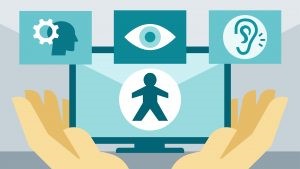Tools for enhancing digital accessibility
We will shortly cover tools transforming text to speech, speech to text, and accessibility checkers
Tools transforming text to speech
- ReadSpeaker TextAid (licenses available)
- Read aloud PDFs (built in)
- Free screenreaders likes NVDA or ReadAloud you can download or Microsoft Narrator (built within Windows 10, to be activated with Windows-logotoets + Ctrl + Enter)
- Activate Immersive reader in Canvas (in your personal settings after login to Canvas).
Tools transforming speech to text
Captioning for the deaf and hard of hearing can be done by adding subtitles to videos (or switching them on as a viewer in YouTube) or you can activate live captioning in Zoom or MS-Teams. Live captioning can also be saved and added to the recording of a session.
Note:
- Only available in English
- In Zoom only the person who actually created the session can activate the option
Accessibility checkers
If you created documents or web content you can check the accessibility before sharing. Microsoft has a built-in option (fill in ‘accessibility checker’ in the menu field ‘Tell me what you want to do…’) or Adobe Acrobat accessibility checker (PDF), to give insight about your documents.
Before offering web content on a website like for instance a Canvas course, you can make use of the WAVE web-accessibility evaluation tool, based on the above mentioned web content accessibility guidelines (WCAG). Note: WAVE cannot tell you if your web content is accessible. Only a human can determine true accessibility. However, WAVE can help you, as a human; evaluate the accessibility of your web content.
![]()
This article is licensed under a Creative Commons Attribution 4.0 International (CC BY 4.0) License.

Library update
Related:
- UM website about Accessibility
- UM Disability Support
- Library services for disabled users

0 Comments